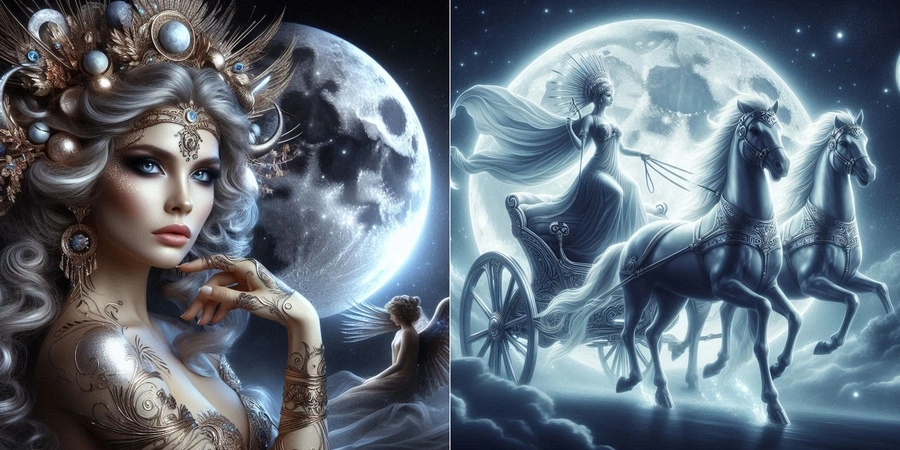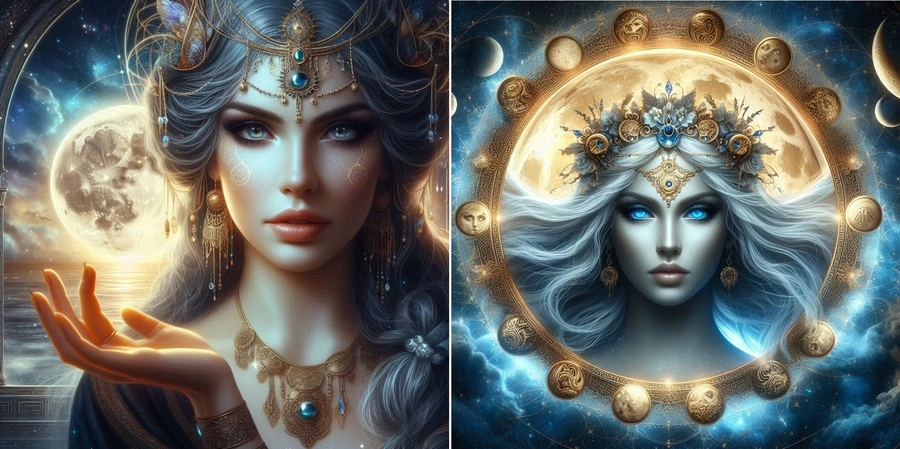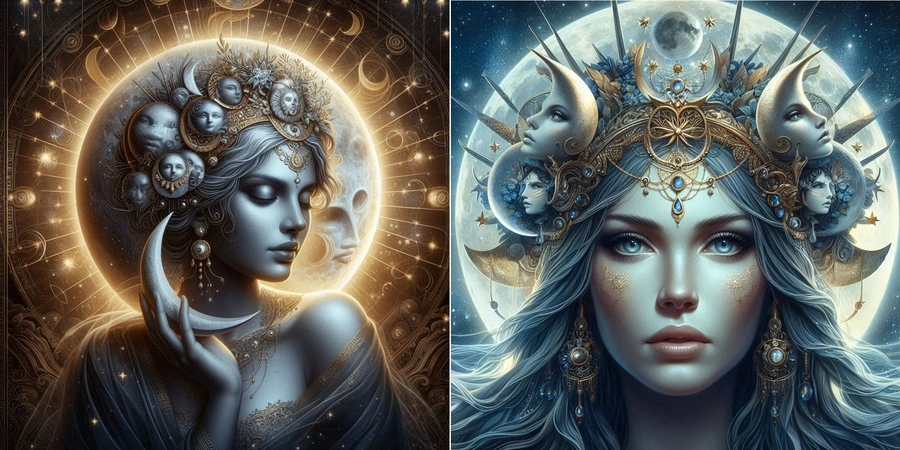
Selene was the goddess of the moon, often depicted as a beautiful woman with a crescent moon on her forehead. As a Titaness in Greek mythology, Selene was the daughter of the Titans Hyperion and Theia, who were themselves the children of the primordial deities Gaia and Uranus.
Selene, known in Roman mythology as Luna, is often depicted as a radiant goddess riding a silver chariot drawn by two horses across the night sky.
Selene held dominion over the celestial spectacle that bathed the night in its silvery glow – the Moon. More than just a glowing orb, Selene embodied the moon itself, weaving a tapestry of myths and legends around her luminescence.
The Story of Selene
According to the myths, Selene fell in love with the mortal shepherd Endymion and would visit him every night while he was asleep. She would gaze upon him lovingly, and some versions of the story suggest that she even had children with him. However, the relationship was not without its challenges. The god Zeus became jealous of Selene’s affection for Endymion and put him into an eternal slumber so that he would never age or die.
Another significant myth involves Selene and the god Pan. Pan, enchanted by Selene’s beauty, gifted her a herd of white oxen. This myth not only highlights Selene’s divine allure but also her association with animals and nature, further cementing her role as a goddess who bridges the celestial and terrestrial realms.

Selene’s association with the moon also linked her to concepts like lunacy (believed to be influenced by the moon’s phases) and childbirth, as the cycles of the moon mirrored the menstrual cycle. In some regions, Selene was linked to Hecate, the goddess of magic, crossroads, and witchcraft, as both held sway over the nighttime realm.
Selene was also associated with the goddess Artemis, who was her sister. Together with their brother Apollo, they formed a triad of deities representing the sun, moon, and earth. Selene was responsible for the phases of the moon, and it was believed that she drove her chariot across the sky each night, pulling the moon behind her.
Selene’s family tree was a complex one, as was common in Greek mythology. Her father was Hyperion, one of the Titans, while her mother was Theia, another Titan. Selene had several siblings, including Eos (the goddess of the dawn) and Helios (the god of the sun). She was also the aunt of the god Hermes and the mother of several children, including Pandeia (the goddess of dew) and the demigod Narcissus.
Selene: Goddess Powers and Abilities
Revered for her luminous presence in the night sky, Selene’s powers transcend mere illumination, encompassing aspects of magic, fertility, and divine authority.
- Luminescence and Moonlight: Selene’s most fundamental power lies in her ability to illuminate the darkness with moonlight. As the personification of the Moon, Selene radiates a gentle, silvery glow that bathes the Earth during the night hours. Her light not only provides visibility but also symbolizes clarity, guidance, and the passage of time. Ancient Greeks believed that Selene’s luminous presence could inspire awe and contemplation, illuminating both the physical world and the spiritual realm.
- Influence Over the Lunar Cycle: Selene governs the phases of the Moon, from the waxing crescent to the full moon and through to the waning crescent. Each phase symbolizes different aspects of her power and influence. The waxing moon reflects growth, renewal, and the gathering of energy, while the full moon represents Selene at her most potent and radiant. Conversely, the waning moon signifies withdrawal and reflection, echoing the cyclical rhythms of nature and life itself.
- Control of Tides and Waters: In Greek mythology, Selene is often associated with the control of tides and waters. She is believed to possess the power to influence the ebb and flow of the oceans, a concept rooted in the observation that tidal patterns correlate with the phases of the Moon. Sailors and coastal communities looked to Selene for protection and guidance, attributing the rise and fall of the tides to her celestial authority.
- Magical and Mystical Abilities: Beyond her natural phenomena, Selene is revered for her magical and mystical abilities. As a goddess closely tied to the night, she is believed to have a deep understanding of sorcery, divination, and lunar magic. Selene’s connection to the unseen and the mysterious aspects of existence underscores her role as a mediator between mortal realms and the divine. Her temples were often sites of nocturnal rituals and offerings, seeking her favor for blessings or insight.
10 Myths and Facts About Selene
Selene, the ancient Greek goddess of the Moon, holds a captivating position in mythology and cultural history. Her stories are rich with intrigue, beauty, and mysticism, making her a figure of enduring fascination.
- Selene’s Chariot: One of the most distinctive images of Selene is her nightly journey across the sky in a chariot drawn by winged horses or oxen. This myth underscores her role as the bringer of moonlight and her nightly traversal symbolizes the passage of time and the consistent rhythms of nature.
- The Moon’s Phases and Selene’s Influence: In mythology, the phases of the Moon are often attributed to Selene’s moods and actions. When the moon waxes, it is believed that Selene is at her most potent and active, while a waning moon reflects her retreat. This interpretation links the goddess closely to the observable lunar cycles, emphasizing her direct impact on the natural world.
- Selene and Zeus: Selene is sometimes depicted in myths as having a relationship with Zeus, the king of the gods. From this union, she bore several children, including Ersa, the goddess of dew. This connection with Zeus highlights her status among the Olympian gods and her role within the broader Greek pantheon.
- Selene’s Connection to Sleep and Dreams: As a night deity, Selene is closely associated with sleep and dreams. The gentle light of the Moon, believed to be her presence, was thought to influence dreams and provide a peaceful sleep. Temples dedicated to Selene sometimes served as places where people sought oracular dreams or divine guidance in their sleep.
- Selene and the Underworld: hile primarily associated with the night sky, Selene also held a connection to the underworld. In some regions, she was considered an aspect of Hecate, the goddess of magic, crossroads, and the spirits of the dead. This association stemmed from the moon’s illumination of the night, a time when the veil between the living and the dead was believed to be thinnest.
- A Universal Luminous Presence: Selene wasn’t just worshipped in Greece. The Roman goddess Luna is her direct counterpart, embodying the moon in Roman religion. Even today, our words “lunatic” and “lunar” bear the imprint of Selene’s celestial influence, a testament to the enduring power of her mythology.
- A Beacon for Travelers: Beyond her celestial duties, Selene played a vital role for travelers. The moon’s consistent light provided navigation at night, guiding sailors across vast stretches of water and helping weary travelers find their way home. In some regions, Selene was specifically worshipped as a protector of travelers, ensuring their safe passage under the cloak of darkness.
- Selene’s Role in Agriculture: In ancient agricultural societies, Selene was revered for her influence over planting and harvesting cycles. The phases of the Moon, governed by Selene, were believed to affect the growth of crops. Farmers would often plant and harvest according to the lunar calendar, seeking Selene’s favor for a bountiful yield.
- Selene and Ocean Tides: Mythologically, Selene was believed to have a profound influence over the ocean tides. This idea predated scientific understanding and was rooted in the observation that the tides were highest during the full and new moons. Thus, Selene was credited with the power to move the vast oceans, a testament to her immense strength.
- The Lunar Eclipse and Selene: Lunar eclipses were viewed with a mix of awe and fear in ancient Greece. They were often interpreted as moments when Selene was overshadowed or in distress. These celestial events were surrounded by myths explaining why the moon might disappear and were occasions for special prayers and rituals to appease the goddess.

The Symbols of Selene
Selene, the Greek goddess of the Moon, is a figure shrouded in mystery and celestial beauty. Her presence in mythology is not only marked by her tales but also by the rich array of symbols associated with her.
The Crescent Moon
Perhaps the most recognizable symbol of Selene is the crescent moon. Often depicted as a diadem or a crown resting upon her head, the crescent moon signifies her dominion over the night and her embodiment of the lunar phases. This symbol highlights the waxing and waning nature of the Moon, mirroring the cycles of growth, decline, and renewal. In artistic representations, the crescent moon not only identifies Selene but also emphasizes the cyclical rhythm of time and nature that she governs.
The Full Moon
While the crescent moon is a prominent symbol, the full moon also holds significant importance in representing Selene. The full moon’s completeness and brightness symbolize Selene’s full power and illumination of the night sky. This symbol is often associated with the goddess’s ability to light the darkness, providing guidance and clarity. The full moon’s appearance was a time of celebration and ritual in ancient Greece, during which Selene’s influence was at its peak.
The Chariot
Selene’s chariot, often drawn by two horses or oxen, is a central symbol in her iconography. This chariot represents her nightly journey across the sky, bringing light to the world during the hours of darkness. The imagery of Selene driving her chariot through the heavens signifies her active role in the celestial order and her control over the passage of time. The chariot’s movement through the night sky also symbolizes the steady, unchanging nature of the lunar cycle.
The Veil
In many depictions, Selene is shown wearing a flowing veil, which serves as a symbol of mystery and the unseen aspects of the night. The veil reflects the idea that the Moon, and thus Selene, has a hidden side—much like the phases of the Moon reveal and conceal different portions of its surface. This symbol underscores the mystical and enigmatic qualities of the goddess, emphasizing her connection to the unknown and the nocturnal.
The Torch
The torch is another significant symbol associated with Selene. It represents her ability to illuminate the darkness and guide travelers through the night. The torch’s light is a metaphor for knowledge and enlightenment, suggesting that Selene’s influence extends beyond mere physical illumination to include spiritual and intellectual guidance. In rituals and art, the torch underscores Selene’s role as a beacon of hope and a source of clarity amidst the shadows.
The Cloak of Stars
Selene is sometimes depicted with a cloak adorned with stars, symbolizing her dominion over the night sky and her connection to the broader cosmos. The starry cloak signifies the goddess’s integration with the universe and her role in the cosmic balance. Each star in the cloak can be seen as a point of light that contributes to the overall brilliance of the night, reflecting Selene’s ability to bring light and order to the world.
The Lunar Animals
Various animals, particularly those associated with the night, are linked to Selene and serve as her symbols. White horses, oxen, and sometimes even wolves are depicted in relation to Selene, symbolizing strength, purity, and the wild, untamed aspects of the night. These animals represent the various attributes of the Moon and its goddess, from the gentle and nurturing to the powerful and formidable.
The Lunar Disc
The lunar disc, often seen behind Selene’s head or as a separate symbol, represents the complete and unblemished Moon. This symbol is a powerful emblem of her authority and purity. The disc’s roundness signifies completeness and unity, highlighting Selene’s role in the cosmic order. It serves as a reminder of the Moon’s presence and its influence on the Earth’s natural cycles.
The Colors of Silver and White
Silver and white are the dominant colors associated with Selene. Silver, with its shimmering and ever-changing nature, mirrored the moon’s luminescence and its connection to the mysteries of the night. White, often associated with purity and new beginnings, symbolized Selene’s connection to childbirth and the cyclical nature of life.
The Dew and the Flowers that Bloom at Night
In some myths, Selene was linked to the element of dew, believed to be the tears of the moon. Dew, nourishing the earth at night, symbolized Selene’s nurturing and life-giving aspects. Certain flowers, particularly those that bloomed at night or released their fragrance under the moon’s glow, were also associated with her. These flowers, often white or silver, represented beauty, purity, and the hidden magic of the night.
| Selene, the enchanting goddess who embodied the moon in Greek mythology, wasn’t just a celestial being; she was a tapestry woven with symbols that offered a deeper understanding of her role and influence. |